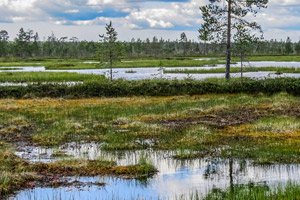
All iLive content is medically reviewed or fact checked to ensure as much factual accuracy as possible.
We have strict sourcing guidelines and only link to reputable media sites, academic research institutions and, whenever possible, medically peer reviewed studies. Note that the numbers in parentheses ([1], [2], etc.) are clickable links to these studies.
If you feel that any of our content is inaccurate, out-of-date, or otherwise questionable, please select it and press Ctrl + Enter.
Peatlands can counteract global warming
Last reviewed: 02.07.2025
 ">
">In conditions of high humidity and temperature, peatlands absorb large amounts of carbon dioxide, which can slow the onset of global warming.
Scientists largely attribute the mechanism of global warming to the so-called greenhouse effect. Short-wave solar radiation easily overcomes the atmospheric layer of our planet. The Earth heats up and reflects long-wave rays, for which the atmosphere is not so transparent: it contains greenhouse gases with CO2 in its composition. This leads to a concentration of energy at the earth's surface, which entails additional heating of the Earth.
The problem could be solved by reducing the level of carbon dioxide: for example, plants that use CO 2 for photosynthesis are capable of doing this. Incidentally, there are large amounts of bound carbon dioxide – we are talking about peat bogs, which occupy no more than 3% of the earth's surface and yet accumulate about 500 gigatons of carbon. This amount exceeds the accumulation of all forests on the planet.
Scientists from Russia and Great Britain have studied a number of peatlands located in western Siberia. Using hand tools, the specialists extracted columns of peat deposits, determined the date of radiocarbon complexes, and described plant particles and single-celled microorganisms that are distinguished by their rapid response to any shifts in the environment.
As a result, the age of the deepest layers was determined. It was more than nine thousand years. At that time, the Siberian region was distinguished by a mild climate and a large amount of precipitation. Residual traces of sphagnum moss and compact mini-bushes were found in the peat deposits, the growth of which does not require the presence of many nutrients.
Almost six thousand years later, the climate warmed up, and precipitation decreased. A layer with predominantly cotton grass and xerophilic forms of testate amoebae appeared in the peatlands – the simplest ones capable of surviving a long absence of moisture. The dry period was replaced by a wet one, and then drought set in again.
As the authors of the study explain, the Atlantic period was the most informative. According to scientists' calculations, in about three decades in western Siberia, global warming will lead to an increase in temperature by about 0.9-1.5°C, and the humidity level will increase by 12-39%. Similar phenomena already occurred about eight thousand years ago, and it was at this time that strong absorption of atmospheric carbon by peatlands was noted.
Of course, we should not expect that peat bogs will be able to block global warming processes. However, they are able to slow down their development for a certain period of time, which is also important.
You can read more about the study on the page.
